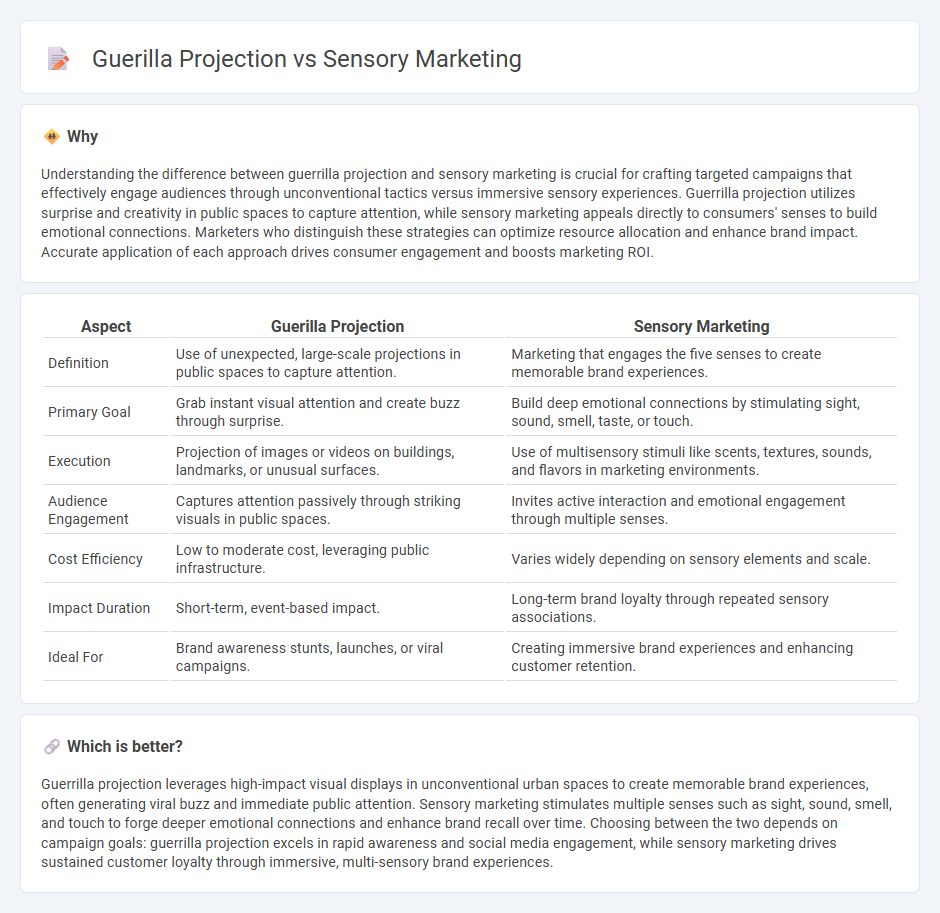
Guerrilla projection leverages unexpected, large-scale visuals in public spaces to capture attention and create memorable brand experiences, while sensory marketing engages multiple senses such as touch, smell, and sound to deepen emotional connections with consumers. Both strategies aim to enhance brand recall and influence consumer behavior through innovative, immersive techniques. Explore the unique benefits and applications of guerrilla projection and sensory marketing to elevate your brand impact.
Why it is important
Understanding the difference between guerrilla projection and sensory marketing is crucial for crafting targeted campaigns that effectively engage audiences through unconventional tactics versus immersive sensory experiences. Guerrilla projection utilizes surprise and creativity in public spaces to capture attention, while sensory marketing appeals directly to consumers' senses to build emotional connections. Marketers who distinguish these strategies can optimize resource allocation and enhance brand impact. Accurate application of each approach drives consumer engagement and boosts marketing ROI.
Comparison Table
| Aspect | Guerilla Projection | Sensory Marketing |
|---|---|---|
| Definition | Use of unexpected, large-scale projections in public spaces to capture attention. | Marketing that engages the five senses to create memorable brand experiences. |
| Primary Goal | Grab instant visual attention and create buzz through surprise. | Build deep emotional connections by stimulating sight, sound, smell, taste, or touch. |
| Execution | Projection of images or videos on buildings, landmarks, or unusual surfaces. | Use of multisensory stimuli like scents, textures, sounds, and flavors in marketing environments. |
| Audience Engagement | Captures attention passively through striking visuals in public spaces. | Invites active interaction and emotional engagement through multiple senses. |
| Cost Efficiency | Low to moderate cost, leveraging public infrastructure. | Varies widely depending on sensory elements and scale. |
| Impact Duration | Short-term, event-based impact. | Long-term brand loyalty through repeated sensory associations. |
| Ideal For | Brand awareness stunts, launches, or viral campaigns. | Creating immersive brand experiences and enhancing customer retention. |
Which is better?
Guerrilla projection leverages high-impact visual displays in unconventional urban spaces to create memorable brand experiences, often generating viral buzz and immediate public attention. Sensory marketing stimulates multiple senses such as sight, sound, smell, and touch to forge deeper emotional connections and enhance brand recall over time. Choosing between the two depends on campaign goals: guerrilla projection excels in rapid awareness and social media engagement, while sensory marketing drives sustained customer loyalty through immersive, multi-sensory brand experiences.
Connection
Guerilla projection and sensory marketing connect through their focus on creating immersive, memorable brand experiences that engage multiple senses beyond traditional advertising. Guerilla projection uses striking visual displays in unexpected locations, enhancing sensory marketing's goal to stimulate sight and evoke emotional responses. Both strategies leverage sensory stimulation to increase brand recall, deepen consumer engagement, and drive spontaneous word-of-mouth promotion.
Key Terms
**Sensory Marketing:**
Sensory marketing leverages the human senses--sight, sound, smell, touch, and taste--to create memorable brand experiences that enhance customer engagement and emotional connection. Brands use techniques like ambient scents, tactile packaging, and immersive audio to influence consumer behavior and increase brand recall. Discover how sensory marketing can elevate your brand strategy and drive customer loyalty.
Multisensory Experience
Sensory marketing leverages multiple sensory channels--sight, sound, touch, taste, and smell--to create immersive brand experiences that influence consumer perception and behavior. Guerilla projection uses unexpected visual displays in public spaces to capture attention and evoke emotional responses, prioritizing visual impact but often integrating sound or tactile elements for enhanced engagement. Explore deeper into how these innovative strategies craft powerful multisensory experiences that redefine audience interaction.
Emotional Response
Sensory marketing leverages multi-sensory stimuli such as sight, sound, smell, touch, and taste to create strong emotional connections and enhance brand recall. Guerilla projection specifically uses large-scale visual projections in unexpected urban environments to evoke surprise and curiosity, driving high-impact emotional engagement. Discover how these innovative strategies can transform your brand's emotional resonance and consumer interaction.
Source and External Links
Sensory branding - Sensory marketing is a strategy that appeals to consumers' five senses to create emotional connections and improve brand perception beyond traditional rational marketing approaches.
Unlock Sensory Marketing: What it is and Why it Works - Glion - Sensory marketing involves engaging all five senses--sight, sound, touch, smell, and taste--to build stronger, more intimate brand experiences, as exemplified by Apple and Starbucks.
Sensory Marketing | How Brands Use the 5 Senses - Sensory marketing is an advertising approach that triggers emotions and reflex associations via sounds, scents, colors, textures, and tastes to make brands more memorable and increase customer loyalty.
 dowidth.com
dowidth.com